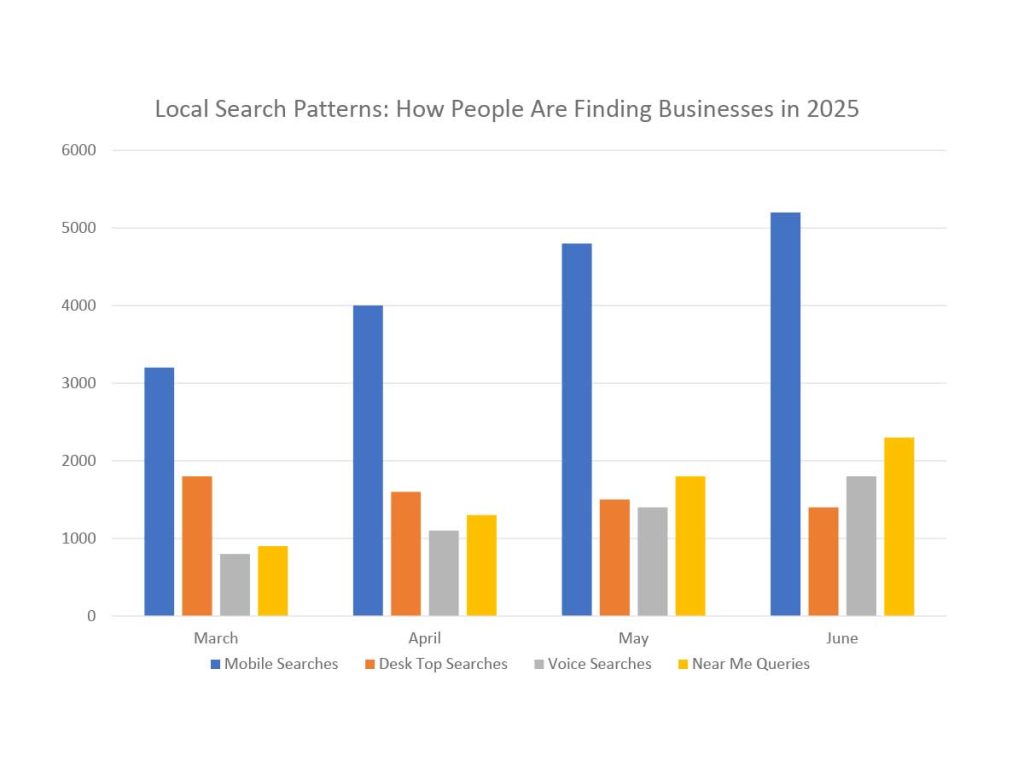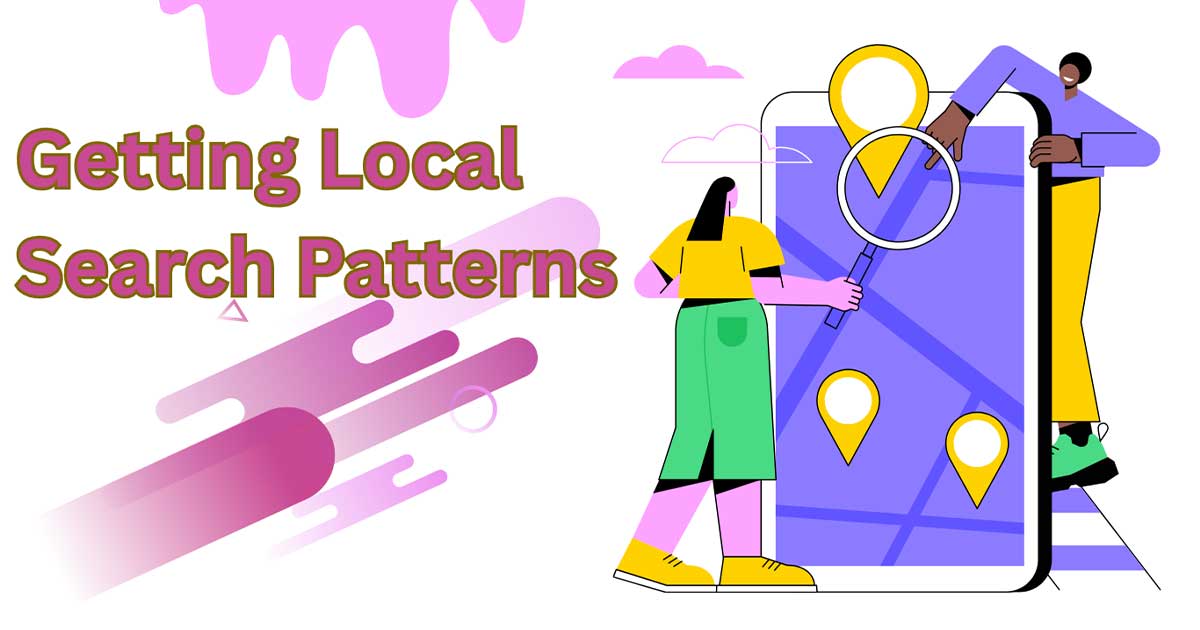Getting Local Search Patterns
What do today’s local search trends show?
Picture someone in a car typing, “Best taco place near me.” This shows they want a taco but also need it right away. Watching these cues helps businesses figure out when people use Google Maps instead of phonebooks.
Local search patterns reveal who, how, and when people search.
Factors such as peak hours or preferred devices help predict customers’ needs. If taco lovers search more on Friday nights, restaurants can plan their staffing and specials accordingly.
This post will explain why local search habits matter.
Understanding them gives owners a jumpstart in reaching customers in 2025 and beyond. It’s not magic just knowing your neighbors online.
Key Takeaways:
- Shoppers check phones first. Firms show products well. Owners stock schedule offers based on requests. Visibility is key.
- Update Google Profile with hours and pictures. Take inquiries and reviews as chats. Builds trust and lifts local rank.
- Chains keep brands yet twinkle info per location. Simple local update reminds Google shoppers where to shop.
- Link nav apps, Apple Maps post geotag. Wide reach from presence on several platforms, e.g., coffee nearby.
- The owner profile loses efficiency over time. Several groups help owners out.
Understanding Local Search Patterns in 2025
To be found by nearby customers, your Google Business Profile has to be correct and trustworthy. The profile should have all the right phone numbers, photos, and service descriptions. This is almost like welcoming local shoppers. Responding nicely to online reviews also helps build your profile.
Getting Multi-Location Businesses
When brands have stores in several places, it’s not easy. They need a strong SEO plan that “connects everything. It should show the unique sides of each place except for the main sites. The main plan needs to be uniform, while local pages should focus on local keywords, landmarks, and things that matter to folks. In every zip code.
Looking Beyond Google Maps
Shoppers today don’t use just Google Maps. A good local strategy must also consider Apple Maps, Bing Places, and probably all the map apps used in the area. Using ads based on location is also ideal. By grouping these tools together on one dashboard, owners can quickly analyze what works and what does not. There’s no guesswork involved at all.

Keeping Your Finger on the Pulse
Your polished campaign is only half of the job. The other half involves regularly checking ranks, engaging with locals on social media, plus looking at keyword data. Google Search Console shows which traffic-generating terms are used, while community posts indicate when small giveaways could be done. This way, small problems do not grow into lost foot traffic due to a lack of interest from customers.
Key Trends Shaping Local Experience
Finding out what locals want is now made easier by new technology. By tracking browsing and clicking habits, it’s possible to personalize the results-users see exactly what they need when they need it.
People use their phones to find stores around them. Surveys show that 76% of buyers search on their phones before going out. So brands must think mobile-first. They will lose customers who need fast info.
Impact on Business Discovery
The way people search affects how they find businesses. The search bar opens a conversation. Therefore, I could put time into online profile optimization, appearing on maps, and responding to reviews.
The statistics prove this point; about 99% of local searches use Google. This monopoly makes visibility there essential for survival. Winning this spot on the map has insights that help brands grow and attract new customers.
The Power of Local Search Patterns Intent
Search intent gives stores signals on stock levels or opening hours. Owners can interpret what neighbors want by looking at this information. This way, they turn online taps into foot ones or phone rings.
However, not all searches have the same purpose, though. There are three groups of people who hit the “find near me” button. First, some want immediate directions for lunch now. Second, others check reviews or working hours before going tomorrow. Finally, a few look for deals to collect within the next trip.
Find beings seeking first aid plumbing services nearby or late-night diners. This trend aligns with common Local Search Patterns
Research shoppers browsing lists with intentions to purchase later, such as dry-cleaning services or car repairs. People, Mr. Search for something nearby before deciding where to go shopping.
Location-Based Queries
Their location matters. They might type in “ice cream shop” or just rely on their phone’s GPS. If shops match what customers search for in real time, these shops will have considerably higher chances of attaining web traffic from those real customers.
The time of day cues the need.
- 1) Right now: fix sinks, see a doctor, clean carpets.
- 2) This evening: dinner, plays, hotels for weekends.
- 3) Regularly: groceries weekly, yardwork monthly, taxes year annually. Offering what customers want at the appropriate times will increase clicks and sales.
Local needs comprise three aspects. WHERE are they? What is their need? How urgent is it?
User Behavior:
The past searches, clicks, and reviews next determine what people expect to find.
All of this makes clear why some shoppers buy fast while others just bookmark things. Knowing this helps shops show up at just the perfect moment for the customers. This trend aligns with common Local Search Patterns
When looking for something close by, we don’t only type a few words into our phones and hit search. Instead, we add a cue about where we are, like “pizza near me” or “library on Maple Street.” These little clues help search engines generate results that actually fit the immediate area.
Time and Urgency Factors
Timing is everything, too. For example, you pull out your phone at 7 am while desiring coffee. Search results at that time should show the diner with fresh coffee, not the bar that opens later.
Furthermore, most individuals have a fairly good idea of what they want before searching. Thus, customers type “vegan lunch café” instead of just “café”. This enables Google and such services to serve up results matching our hunger and location promptly.
90% of shoppers check local information daily. This is rising. Google is the go-to for local searches, with 99% using it. Businesses must keep their Google profiles current.

Searching for a Local Business
Brands can enhance strategies by examining the vernacular, timing, and means utilized by clients. Subsequently, they could convert inquiries into store visits and calls. This trend aligns with common Local Search Patterns
When searching for a local business, the primary details are:
- 82% want the address.
- 76% desire hours.
- 75% need a phone or email.
Make sure this information is easy to find on websites and social media.
Distance Matters
Most U.S. shoppers go 8 miles for purchases. So ads, maps, and flyers should concentrate on this radius. Do not limit marketing to local; consider the distance, too. This trend aligns with common Local Search Patterns
The Review Ritual
People look at reviews before they shop:
- People read 4 or 5 reviews.
- 41% trust online reviews like advice from friends.
- 84% say reviews affect their choices to buy.
Good reviews make a big difference.
Shopping Preferences
People want to shop how they like:
- Half of them look online before going to stores.
- A quarter want delivery.
- Others mix online and in-store shopping.
Flexibility is important for businesses to understand.
Using Local Data
Local numbers tell a story. Use them to set store hours and stock what people want. Adjust ads to reach people nearby. Small changes based on behavior patterns increase store traffic. This trend aligns with common Local Search Patterns
Customer Journey
By watching local searches, businesses learn about customer journeys from wonder to purchase. They see what words people use, which questions they ask, and who they compare products with. This way, they can tailor their offerings and marketing strategies for the local area.
Turning Data into Action Steps
Data in a spreadsheet does not assist anyone until it is utilized. Here are a few concrete actions that will help you convert statistics into tangible results:
- Focus on feedback: Find recurring remarks in evaluations to discover customers’ preferences and aversions.
- Identify the successes: Establish which of your venues are exceptional and see if their strategy can be implemented in other locations.
- Change the timing: If searches peak at lunchtime, think about opening slightly earlier or staying open a tad later.
- Adjust the menu: Provide what local customers are searching for rather than following a uniform list.
- Go local with promotions: Implement specials that feel exclusive to each neighborhood instead of a dull company-wide discount.This trend aligns with common Local Search Patterns
What Local Search Patterns Will Tell You About Your Customers in 2025
Have you ever thought about how your neighbors search on their phones at different times, like breakfast?
The shift in search habits is Local Search Patterns.
People search differently at different times. Commuters may search for a coffee shop, while homeowners look for a plumber at night. These are local search behavior trends that vary with time or urgency.
Monitoring these shifts shows when customers want something and help in crafting responses to their questions. Such insights are driven by Local Search Patterns
Businesses can learn from local search rhythms and develop effective marketing strategies in 2025 and beyond.
| Pattern Type | What It Tells You | Why It Matters for Local SEO |
|---|---|---|
| Time-of-Day Searches | When users are most active | Helps with ad timing and posting schedules |
| Day-of-Week Trends | Which days bring more searches | Let’s you plan promotions or hours better |
| Device Usage Patterns | Mobile vs desktop search preferences | Ensures your site works great on all devices |
| Seasonal Search Behavior | Popular keywords by month or season | Helps plan content and campaigns |
| Voice Search Queries | How people speak their searches (e.g. “near me”) | Optimizes for natural language and intent |
| Local Map Interactions | Clicks, directions, and call actions from maps | Shows how often people take action |
Stay Ahead with Local Know-How
Looking at what locals search for indicates who your customers are as well as who your competitors are. This inside knowledge enables you to:
- Pinpoint blind spots: Identify neighborhoods or services that others are not adequately serving.
- Create a clear message: Develop an offer so distinct that it is instantly noticeable.
- Target advertisements: Send customized promotions to consumers already searching for similar products.
- Adjust prices: Modify your pricing to suit what people in that region expect and can pay.
Utilize these local pictures in order to formulate more precise marketing campaigns, amaze customers the instant they enter the store, and ensure continuous foot traffic. Keep an eye on the trends and be prepared to adjust your tactics when necessary since the market moves quickly.
The Big Takeaway
By examining local search data, businesses can enhance their online presence, empathize with consumers, and cultivate consistent growth opportunities. Such insights are driven by Local Search Patterns
Metrics That Matter
Through performance data at the local level, businesses can assess their effectiveness.
It indicates performance in various towns and neighborhoods.
Key Performance Indicators
- Near-me search click rates
- Direction requests and navigation apps started
- Calls from local listings
- Website visits from area searches
- Site conversion rates per location
Tracking Geographic Performance
Monitor performance by neighborhoods, cities, or zip codes. This information identifies opportunities for greater local visibility and recognizes currently prosperous regions. For instance, the tracking of location-based search terms can reveal peaks and valleys seasonally in different towns.
Customer Action Metrics
Focus on actions demonstrating strong customer intent:
- Store visits after searching
- Online appointments
- Local inventory searches
- Keep an eye on what customers buy at checkout.
- Watch how they talk on social media and what they think about your stuff.
Changes in Local Searches in Recent Times?
How do people in your town find businesses like yours?
Online local searches reveal how people behave online: they use their hands, fingers, and voice to get businesses in their area. These behaviors shift monthly and seasonally, showing the places where people meet and the devices that they use. Such insights are driven by Local Search Patterns
From March to May, searches using mobile devices and voices increased. Keeping tabs on trends can help you adjust your strategies to be visible when local needs arise.

How local SEO works.
To show up first in local searches, you must use techniques that enhance your visibility when people look for businesses like yours nearby. Such insights are driven by Local Search Patterns
Optimize Your Website.
Include location keywords in your website content. Use the same name, address, and phone number everywhere on your site. Modify meta titles and descriptions accordingly. Such insights are driven by Local Search Patterns
Manage Citations.
Set up profiles in trustworthy places like Google My Business and Yelp. Keep everything consistent across directories. Search engines consider correctly presented citations as trust signals.
Keep actual facts about yourself. Google looks after this. People trust those facts. The more you build that trust with them, the higher the score in local search you get. Such insights are driven by Local Search Patterns
Get Local Links Created.
Links from other websites back into yours are important for building online authority. Work with other nearby businesses, sponsor events, and join relevant groups or associations.
Watch What Users Do
Google looks at how people use your listing on its site. Many clicks, views, calls, and requests for directions show that your place is busy. The more engagement, the better you’re ranking in local searches. Such insights are driven by Local Search Patterns
Tidy Up the Tech Stuff
Backend fixes lead to big wins. Local schema markup is a must for accurate search engine info. Websites must look great on mobile devices and load fast. Happy customers lead to a higher ranking!
Your Google Profile Is Your Front Door
Your Google Business Profile (GBP) is like a shop window that is always open. Wrong hours, address, or phone number means no online visitors. Fresh and correct details pull more foot traffic through your real door.
Key Bits to Keep Updated
- Exact name, address, and phone number (NAP) of business
- Regular and holiday hours
- Main and secondary categories of business
- Pictures from inside and outside the shop
- The boundaries of the service area
Quick Tips for Ongoing Care
Heading towards consistency – match the contact details in all places. As soon as holidays or events arise, change hours quickly to avoid upsetting customers.
The correct business types convey your identity and your offering. Select suitable categories, and consistently refresh your online presence.
Visual Content Strategy
New pictures distinguish your profile. Pictures attract. Add the following: images of the building outside, interior ambiance, team, and closeness to the goods/services in action.
Update the images regularly to show what’s new, especially if modifications have been made recently.

Review Management and Social Proof
Reviews act as personal recommendations; thus, your rating is critical for local traffic. Monitor review sites while responding quickly. Local Search Patterns reveal important user behavior
Managing Online Reviews
Thanking indicates good feedback, and handling complaints demonstrates care; both require promptness in responding. Local Search Patterns reveal important user behavior
Leveraging Social Proof
Display excellent reviews on website/social media as mini testimonials that invite others to experience. Local Search Patterns reveal important user behavior
Build Review Strategy
Make getting feedback routine
- Immediate thank-you email after purchase.
- QR code on receipts.
- Checkout inquiries.
A soft, gentle reminder does wonders. It helps you collect constant new reviews, thus improving reliability & visibility locally. Local Search Patterns reveal important user behavior
Five stars aren’t just bonuses; they help grow businesses & rank higher in Google Maps. To boost ratings, simply tell staff to ask, ‘Please review us’ when happy clients leave, for instance, immediately after eating or fixing the car.
Then, place QR codes at tables or counters. Clients will scan them, go to your review page, & quickly give feedback. Finally, disclose those awesome comments on websites, social media posts, & emails. Show every future customer that good service matters. Such insights are driven by Local Search Patterns
Multi-Location Brand Strategy
For multiple branches, maintain brand unity while allowing local flavor. There should be clear brand guidelines regarding logos/colors/tones, etc, to ensure consistency across locations. But there must also be flexibility; allow stores to have regional specials, use local photos, and adjust holiday hours, for example. This balance gives people a sense of community belonging yet maintains national identity. Such insights are driven by Local Search Patterns
Technical Implementation
Each spot is like its own site. Make pages that show photos, staff info, and maps for “Main St. Coffee Shop” too. Local reviews help search engines find you.
Have Google profiles for each place. Use the same name, address, and phone everywhere. That builds trust with folks.
Stick to rules but let us know what fits in each place. Our look stays the same while feeling different.
Get smart with local SEO tools now! Use schema markup. It helps searchers find hours, pay options, and service areas. Rich snippets increase clicks. Such insights are driven by Local Search Patterns
Content Localization
People do not like reading the same old thing, and as a result, they create landing pages that resemble those written by friends and neighbors. Enumerate landmarks, popular events, or nearby parks to respond to the specific inquiries of locals on each page. Google is more likely to regard you as a local if your words sound more realistic. Such insights are driven by Local Search Patterns
Mobile-First Approach
Keep in mind that 75% of local searchers go to a store on the same day, and they do so on their mobile devices. Therefore, ensure that your website loads quickly and appears well on small screens while making it simple for users to click call buttons, maps, and directions. The smooth mobile experience you provide can entice quick searchers to become paying clients. Understanding Local Search Patterns helps guide these decisions

Platform Integration and Tools
To have your website appear excellently on phones, first make it load quickly. Use banners that contain only text, minimize heavy videos, and check for user-upload times on Wi-Fi connections as well as slow data networks. Then, add click-to-call buttons, letting users call with just one tap, joined by easily accessible map links. The best way of doing this is – displaying large shining buttons at the upper side of the screen, especially in retail/service businesses.
Furthermore, introduce Accelerated Mobile Pages (AMP). This format eliminates excessive codes, thus providing lightweight pages that load almost immediately. Understanding Local Search Patterns helps guide these decisions
Although it is technically demanding to shift to AMP, the outcome will be more satisfied visitors who are at an advantage over competitors. For your tireless engagement- spend hours executing these tasks. The rewards will include reduced bounce rates plus increased sales, so do not hesitate!
Voice Search Optimization
Voice search isn’t just a cool feature on our phones anymore—it’s become part of how we look for answers every day. To make sure people find your content when they ask questions out loud, tweak your writing to sound more natural. Think about how someone would speak, not write, and build long-tail keywords around those everyday phrases. And don’t forget about locals; double-check that your maps, hours, and directions are ready to answer voice queries quickly. Such insights are driven by Local Search Patterns
Google Maps Integration
When most people search for a nearby coffee shop, they’re probably looking at Google Maps first. That’s why this platform should sit at the center of your local strategy. With features like instant location sharing, update alerts, and an easy way for customers to leave questions or reviews, Google Maps lets you run a mini storefront online. Pair that with a well-kept Google Business Profile, and you’ll be ready to catch curious passersby in real-time. Such insights are driven by Local Search Patterns
Apple Maps Connect
If you’re eyeing the iPhone crowd, Apple Maps deserves your attention. Thanks to Apple Business Connect, you can update hours, post photos, or even share a promotional QR code that pops up right when people scan a product. These small touches can turn a casual map search into an actual visit, so give your Apple listing the same TLC you’d give its Google counterpart. Understanding Local Search Patterns helps guide these decisions
API Implementation
Connecting your business tools through an API can make managing your info a whole lot easier. When everything talks to one another, your hours, inventory, and listings stay up to date wherever customers look. This kind of behind-the-scenes automation means less manual work for you and fewer chances for mistakes. Here are a few things a solid API setup normally takes care of:
- Keep all online business listings tidy and identical
- Update holiday or special hours in real-time
- Sync stock levels so customers see what’s really available
- Track what people are saying about you, all from one dashboard
Integration Best Practices
To get the most from those shiny new integrations, follow some tried-and-true habits:
- Use the same name, address, and phone number everywhere customers may look
- Refresh photos, descriptions, and other business details on a regular schedule
- Keep an eye on each platform’s performance reports for sudden changes
- Set up matching pixels or tags so you can see the whole customer journey
Wrapping It Up-Local Search Patterns
What do local search patterns for on the web? Are you aware of these?
Many businesses go astray by concentrating on general SEO suggestions. Look into what your neighbors customarily type into their mobiles. You lose out on easy clients when you don’t pay attention.
Local search patterns say where, when, and with which device people look for what you provide.
It compiles beloved keywords, busy hours, mobile usage, plus seasonal surges. This gives a clear guide to better decisions swiftly.
Grasping local tendencies is essential for great SEO in 2025 onwards.
By analyzing the data, shifting your approach, and connecting with customers at the right times, places, plus deals—turning uncommitted clicks into loyal clients occurs instantaneously.
FAQs
What are local search patterns?
They are common ways people search for local shops and services. Knowing these will help create a good local SEO plan.
Why should I care about local search patterns?
Knowing how locals search helps to serve them better. Looking at patterns shows us what questions they ask and what words they use.
Do local search patterns change my visibility?
Yes, they do! These are the words people use to decide if they see your website or if it gets lost on page two or three of the results
What tools help to analyze local search patterns?
Google Trends shows interest over time; Google Search Console shows queries leading to your site. Local SEO tools like Moz Local and SEMrush give insights into your area.
How should I adjust SEO based on local search patterns?
Update website text, meta titles, and headings with new phrases found. Ensure consistency in business listings. These changes attract more local customers.

